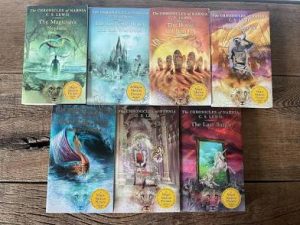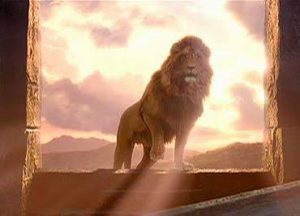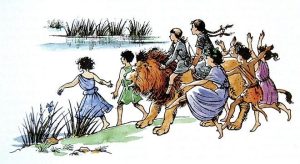Parables of Redemption: The Chronicles Of Narnia

Sometimes God uses His storytellers
like C.S. Lewis to open peoples’
hearts and minds to seeking
redemption in Jesus.
PART ONE:
C.S. LEWIS And Parables Of Redemption
THE CHRONICLES OF NARNIA:

In The Chronicles Of Narrnia
C.S. Lewis has written a series
of wonderful parables delightfully teaching
beautiful lessons about Jesus
and the marvelous life
He has to offer us.
Throughout history God has graciously raised up powerful voices to declare His Good News amidst a particular age, especially during times which seemed particularly difficult. Often these writers have been used to correct and build up the Church as they have told stories or, you might say, parables, which both entertain and enlighten. In the twentieth century C.S. Lewis and J.R.R. Tolkien arose to explore their world, devastated by two particularly horrible World Wars. Interestingly, they both fought in World War I. It is fascinating that C.S. Lewis, through both the horrors he experienced in the infamous World War I trenches, and in his equally tough boarding school years; Lewis walked away from Christianity, On the other hand, J.R.R. Tolkien grew deeper in his faith, and spent years declaring that faith to Lewis. Eventually, through a deeply spiritual and intellectual search, through the guidance of Tolkien and other believing friends, Lewis chose faith in Christ. Then, in the midst of World War II at its worst in England, C.S. Lewis actually served the cause by delivering radio talks which urged his countrymen to look to Christ and God’s Word for direction and hope. Than as the war was ending, Lewis began writing The Chronicles of Narnia for some children he had hosted during the war when they had to be evacuated during the German bombing raids.
I honestly do not remember the first time I read these books. I believe they were introduced to me by a fellow summer missionary during my college years. However, I do remember reading the books after lunch to my students at St. Marys, Georgia seventh graders. I remember how these books captivated them. Now, that’s saying a lot for American seventh graders. So, I took the Narnia books when I went to Jos, Nigeria to teach at Baptist High School, Jos. Many of our students there needed to hear English so they could adapt to an American accent. (I must admit my fellow English teacher who had come from Pennsylvania, had serious doubts about calling my southern accent American.) Nigerian students listened intently as I read The Lion, the Witch and the Wardrobe. These Junior Secondary students reacted emotionally to the ups and downs of Peter, Susan, Edmund and Lucy who had been pulled into the mysterious land of Narnia, desperately needing to be delivered from the White Witch and tyrannical queen. As the story develops, Edmund becomes a slave to this wicked queen, entrapped by her poisonous though delicious Turkish Delight. The King, (the Lion, Aslan,) surrenders His own life to save Edmund. Then He triumphantly rises again and not only defeats, but slays the Queen, freeing Narnia at last. As I read about Aslan’s death, students actually wept, and as He was resurrected, the students cheered. I have never seen a book so powerfully affect students emotions and then their lives. They got it. They recognized Aslan as a type of Jesus, and their hearts rejoiced as he saved Edmund with his royal blood and conquered death.

Though C.S. Lewis would never have used
the title: A Modern Parable Maker;
He was intent to make the wonderful
Love of God in Jesus
known through his
delightful stores and tales.
What caused C.S. Lewis to write The Chronicles of Narnia? It was an act of Christ-like love. Can you imagine what children in London were facing every night during Germany’s nightly bombings? Can you imagine how frightening that would have been? Can you imagine how worried their parents must have felt? Many parents sought people in the safer country-side for their children. C.S. Lewis lived with his brother in The Kilns, a rambling house near Oxford. He took some of these London refugee children in as war-time guests. His was a big heart filled with love for these terrified children. No wonder all seven books feature such realistic and such fascinating children.No wonder we find on almost every page adventure, fun and danger as the Christ-like lion, Aslan, teaches them the power of His self-sacrificing love. C.S. Lewis wrote these books to bring healing to these traumatized children, presenting to them magnificent tales which reached deep inside their hearts with the never-failing hope that Christ brings. So, The Chronicles of Narnia are parables that speak to all of us of a good and perfect Christ who loves us all.
Let’s take a look at one pivotal moment in each book, highlighting just how deeply this Lewis series reflects God and humanity as God offers redemption and various people react, either positively or negatively. In the first book published, The Lion, the Witch and the Wardrobe, Edmund, in particular, has sold out to the evil White Witch. He must be redeemed or die. Aslan gives up His life for Edmund. Susan and Lucy are broken-hearted. Then at dawn Aslan arises victorious. He explains to the girls:

Aslan Resurrected!
Edmund Redeemed!
Death working Backwards!
What more could you ask?
“It means,” said Aslan, that though the Witch knew the Deep Magic, there is a magic deeper still which she did not know. Her knowledge goes back only to the dawn of time. But if she could have looked a little further back, into the stillness and the darkness before Time dawned, she would have read there a different incantation. She would have known that when a willing victim who had committed no treachery was killed in a traitor’s stead, the Table would crack and Death itself would start working backward.”

Lucy and Susan, along with the Old Narnians
celebrate with Aslan his return
to end the treachery of the Telmarines
and to crown a new and faithful King Caspian.
Then in Prince Caspian a dear dying older lady meets the Aslan she has believed in all of her life, although she has never seen Him. Read here how He saves her life:
”They came to a little cottage where a child stood in the doorway crying. “Why are you crying, my love?” asked Aslan. The child, who had never seen a picture of a lion, was not afraid of him. “Auntie’s very ill,” she said. “She’s going to die.” Then Aslan went to go in at the door of the cottage., but it was too small for him. So, when he got his head through, he pushed with his shoulders (Lucy and Susan fell off when he did this) and lifted the whole house up and it fell backward and apart. And there, still in her bed, though the bed was now in the open air, lay a little old woman who looked as if she had Dwarf blood in her. She was at death’s door, but when she opened her eyes and saw the bright, hairy head of the lion staring into her face, she did not scream or faint. She said, “Oh, Aslan! I knew it was true. I’’ve been waiting all of my life. Have you come to take me away?”
“Yes, Dearest,” said Aslan. “But not the long journey yet.” And as he spoke, like the flush creeping the underside of a cloud at sunrise, the color came back to her white face and her eyes grew bright and she sat up and said, “Why, I do declare I feel that better. I think I could take a little breakfast this morning.”

Loyal Reepicheep, who had been terribly
mistreated by Eustace
becomes the most loyal friend
to Eustace the dragon.
Eustace, in The Voyage of the Dawn Treader, one of the most unlikable boys you will ever meet, extremely self-centered and opinionated, actually becomes a dragon. Only Aslan can free him, and He only does so after Eustace’s selfish heart is transformed when his dragonish self realizes how much he needs other people. So, see what Aslan does for this miserable beat who now really wants to be a boy again:
”The very first tear he (Aslan) made was so deep that I thought it had gone right to my heart. And when he began pulling the skin off, it hurt worse than anything I’ve ever felt. The only thing that made me able to bear it was just the pleasure of feeling the stuff peel off. You know—if you’ve ever picked the scab of a sore place. It hurts like billy-oh but it is such fun to see it coming away.”
”I know exactly what you mean,” said Edmund.
”Well, he peeled the beastly stuff right off-just as I thought I’d done it myself the other three times, only it hadn’t hurt—and there it was lying on the grass: only so much thicker, and darker, and more knobbly-looking than the others had been. Then he caught hold of me—I didn’t like that much for I was very tender underneath now that I’d no skin on—and threw me into the water. It smarted like anything but only for a moment. After that it became perfectly delicious and as soon as I started swimming and splashing I found all the pain had gone from my arm. And then I knew why. I’d turned into a boy again. “
So, in The Lion, the Witch and the Wardrobe, C.S. Lewis presents Aslan as a picture of Christ, redeeming not only the traitor, Edmund, but also all of Narnia, and ultimately that entire world. He does so by sacrificing His own life and by being triumphantly resurrected. Next, in Prince Caspian, Aslan once again redeems Narnia and the downtrodden old Narnians, ridding them of the usurping Telmarines, and installing the rightful king, Caspian. Aslan brings the land of Narnia back to HImself and to the Emperor Beyond the Sea. In The Voyage of the Dawn Treader, Aslan works on the detestable, self-centered Eustace Scrubb through submitting him to temporary slavery and other crises, and ultimately to enduring a time actually living as a real dragon, until Eustace longs to become a boy again. That only becomes possible as Aslan, Himself, painfully cuts away layer after layer of selfishness until a purified boy can start life over—looking to Aslan as His Lord.
We see clearly how C.S. Lewis wrote these stories to catch our hearts and minds for Jesus, and to see how completely we can be freed from our old sinful selves as Jesus calls to us, and we respond. These are indeed, redeeming parables. Praise the Lord!
Next week, we will meet others who find that same salvation:
The Silver Chair—Prince Rilian, Eustace Scrubb, Jill Pole and Puddleglum
The Horse and His Boy—Shasta (Prince Cor), Bree, Hwin, Aravis
The Magician’s Nephew—Digory, Polly
The Last Battle—King Tirian, Shift the Donkey, Jewel

Every one of our lives
will also feature very real
adventures if we turn
to Jesus as
our Lord and Savior.